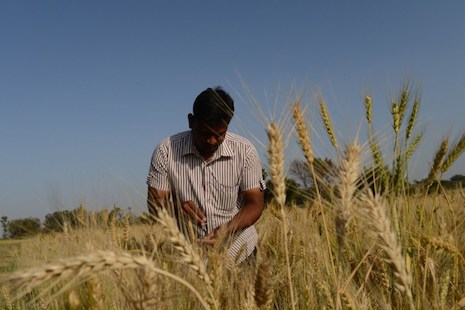Climate fears force big changes on small South Asian farms
Until four years ago, Nepali farmer Sumanti Saru Magar struggled to make ends meet. Every season seemed to bring less rain and higher temperatures, and her paddy field produced barely enough rice to sell in the market.
“The change in climate was going on for quite some time. Paddies needed more water and we are mostly dependent on rains for water, which we were not getting. It was difficult to figure out solutions to this changing situation,” Magar told ucanews.com.
Desperate, Magar decided to convert her 0.4 hectare farm. Instead of cultivating only paddy, as is the traditional method in much of her country, she started growing wheat and vegetables in smaller portions on her land.
The gamble paid off. Buttressed by better soil, the paddy yield has improved. And the multiple types of crops means she has become "less dependent on paddy and has other sources of income”. These days, she is financially independent.
This week, Magar traveled from Nawalprasi district in Nepal to the Indian capital Delhi to take part in a conference on smallhold farming that concluded on Thursday.
About 200 farmers from India, Bangladesh and Nepal attended the event, aimed at addressing issues and challenges that smallholders face amid climate change.
“The major reason for crop loss is the shift in rainfall and temperature and change in the moisture level in the air which affects microbial activities and increases pests and insects that harm crops,” Sunil Simon, South Asia program manager of Strengthening adaptive farming in Bangladesh, India and Nepal (SAFBIN), which organized the program, told ucanews.com.
SAFBIN is a project of Caritas India, the social arm of the Catholic Church, and is funded by the European Union.
Smallholders are particularly vulnerable to changes in climate as they have less land, limited income and small yields. “The difficult thing is that the farmers are not able to figure out why this change is happening and what can be done to improve the situation,” Simon said. Over time, that may well lead to higher rates of hunger.
Through SAFBIN, smallholders like Magar learn about alternative methods of farming such as multiple cropping. They improve their water management and seed storage, and pick up practical advice such as using diluted cow urine and other locally available resources to create organic pest controls.

An Indian farmer checks the quality of wheat at his field at Dhamasana village of Kalol Taluka, some 40 kilometers from Ahmedabad (AFP Photo/ Sam Panthaky)
According to government figures, 52 percent of India’s 1.27 billion population supports themselves through agriculture.
About 70 percent of farms in India are less than two hectares and 60 percent of rural families own small farms. That land is particularly dependent on climate stability; 64 percent of the country’s 142 million hectares of cultivated land relies on rain rather than irrigation.
Ramesh Bhalla, a smallholder with 0.16 hectares of land in Sahgarh district of Madhya Pradesh in central India, has begun using organic pest control made of locally available resources — a sustainable farming practice.
“Adapting organic practices has brought a tremendous change to my social and economic status. It not only gives benefits but is also environmentally friendly and sustainable,” Bhalla said.
Bhalla explained that in organic farming, the input cost is less and output is higher.
Diversification of food baskets and adaptive crops have also helped mitigate the effects of climate change on smallholders.
In Mandla district of Madhya Pradesh, Hari Lal cultivated the traditional Kodo millet after excessive rains threatened his usual harvest of wheat and rice.
The grain ultimately lost ground to wheat and rice as the post-harvest is labor intensive and time consuming but the adaptive qualities of Kodo millet, which can grow under adverse conditions, have proven beneficial.
“We revived and gave value to our traditional food crop. Now I have surplus grain to feed my family and share with fellow farmers,” he said.
The Indian government too is making efforts to help farmers cope with the changing climate. In 2008, then-prime minister Manmohan Singh launched a national action plan on climate change that has eight goals including solar energy, habitat conservation and sustainable agriculture.
Under the national action plan for sustainable agriculture, the government aims to develop drought- and pest-resistant crop varieties, improve methods to conserve soil and provide financial support to enable farmers to invest in and adopt relevant technologies to overcome climate related stress.
“The physical, biological and chemical properties of soil are deteriorating due to the increased use of chemicals on crops and climate change. Soil needs immediate care,” AS Rajput, a scientist at the regional center of organic farming under the Federal Ministry of Agriculture, told ucanews.com.
Rajput said that organic farming is the need of the day. “The area where there is less chemical utilization should be immediately taken up in organic farming,” he said.
The smallholders who attended the Delhi conference expressed hope that they would be able to fight the issues arising due to climate change by sharing their expertise in traditional methods and organic farming to fellow farmers.
“You cannot change nature. This change in climate will go on. We have to make changes in our way of farming and adapt new ways,” Magar said.
Ritu Sharma, Delhi
Source: ucanews.com (Mar. 13, 2015)

